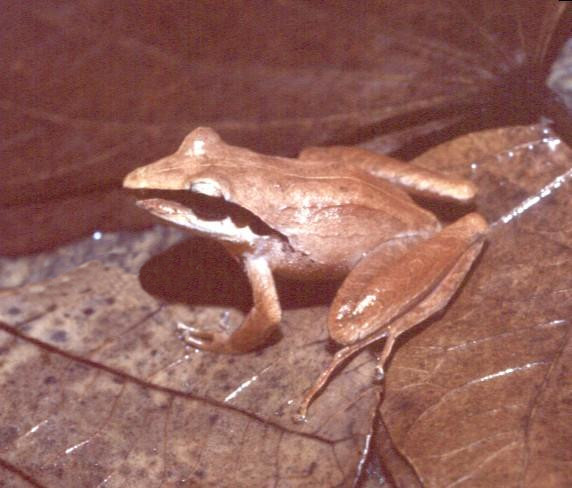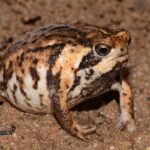- Introduction: A Hidden Jewel of the Brazilian Forest
- Taxonomy and Classification
- Natural Habitat: The Atlantic Forest Gem
- Physical Characteristics: Camouflage and Adaptation
- Behavior and Life Cycle: Secrets Within the Forest Floor
- Ecological Role: Guardians of Environmental Health
- Threats and Conservation Status: Protecting an Elusive Treasure
- Cultural and Scientific Significance: Symbols of Biodiversity
- Conclusion: Joining Efforts to Secure its Future
Introduction: A Hidden Jewel of the Brazilian Forest#
Within the lush emerald layers of Brazil’s Atlantic Forest, hidden beneath leaves slick with moisture and enveloped in the twilight shadows, quietly lives a secretive creature—one few outside the circles of avid herpetologists and local experts have encountered. Meet Ischnocnema hoehnei, a frog species whose quiet existence occupies a vital yet understated role in one of Earth’s most spectacular and simultaneously threatened ecosystems. Although rarely seen, observed, or recorded, this enigmatic amphibian carries immense ecological value and scientific intrigue.
Scientifically named Ischnocnema hoehnei, this remarkable frog is part of the Brachycephalidae family. While many amphibians announce their presence through vibrant hues or deafening choruses, Ischnocnema hoehnei embraces subtlety—its delicate earthy coloration and cryptic habits, acting as quiet but powerful tools of evolutionary mastery.
A curious fact indeed, this little-known frog in some parts has earned the affectionate nickname “forest ghost,” subtly referencing its elusive and cryptic lifestyle. Its muted presence stands in stark contrast to the vibrant biodiversity of its home, making observations and studies all the more precious.
Taxonomy and Classification#
The scientific classification of Ischnocnema hoehnei can provide glimpses into its evolutionary lineage and ecological significance. Belonging to the family Brachycephalidae, this species finds itself housed neatly under the genus Ischnocnema, characterized primarily by direct-developing frogs—amphibians that skip the free-living tadpole stage, developing fully inside eggs laid on land.
This reproductive adaptation situates Ischnocnema hoehnei closely with numerous other Brazilian forest dwellers that depend upon the moist layers of leaf litter rather than streams or ponds. The genus itself is closely related to other terrestrial-oriented frog genera in South America, forming a unique and diverse lineage deeply tied to the region’s rainforest environments.
Natural Habitat: The Atlantic Forest Gem#
The world of Ischnocnema hoehnei begins—and largely exists—in the enigmatic embrace of Brazil’s Atlantic Forest, a biodiversity hotspot stretching along the southeastern coastline of Brazil. Here, moisture-laden air, perpetual shade, and abundant leaf litter provide optimum living conditions. This species primarily inhabits the lower understory, thriving in damp forest litter on the ground, especially near streams and waterfalls hidden within the verdant corridors of pristine and secondary forests.
The Atlantic Forest, a region characterized by rich biodiversity and high levels of species endemism, is a biome burdened with vulnerability. Here, amidst fern-covered rocks, moss-clad tree trunks, and a perpetually damp forest floor lies the carefully balanced niche of the elusive Ischnocnema hoehnei. Humans seldom comprehend this habitat’s complexity—tiny worlds woven within leaves, decaying wood, and shaded earth, each miniature habitat crucial for the continuance of forest diversity.
Physical Characteristics: Camouflage and Adaptation#
Measuring a modest one to three centimeters in length, Ischnocnema hoehnei is not a frog that immediately catches anyone’s eye. Its coloration—a blend of subtle browns, greens, and tans—perfectly mirrors the natural hues of the leaf litter in which it quietly lives out its days. Such cryptic colors and patterns render the species beautifully camouflaged, making it almost invisible to potential predators and even patient human researchers.
However, closer observation, usually reserved for trained eyes through slow and gentle excavation of leaf litter layers, reveals more remarkable qualities. The rough texture of its skin and small warts scattered across its slender body imitate the patterns and textures of damp leaves, twigs, and moss-covered stones, allowing it to melt seamlessly into its environment. Its limbs, slightly elongated yet delicate, aid in navigating the rugged, intricate terrain of leaf litter piles and dense vegetation.
Behavior and Life Cycle: Secrets Within the Forest Floor#
Feeding Habits and Diet#
Primarily nocturnal, Ischnocnema hoehnei ventures out under the cover of darkness, hunting carefully along the moist ground for small arthropods such as ants, spiders, tiny beetles, mites, and insect larvae. Its hunting technique relies less on pursuit and more on patience; using stealth and superb camouflage, the frog ambushes prey that unknowingly wander within striking distance.
Breeding and Reproduction#
The reproductive behavior of this direct-developing frog is fascinating. Unlike typical frogs whose tadpole stages depend on water bodies, Ischnocnema hoehnei produces terrestrial eggs filled with essential nutrients to sustain embryonic development entirely on land. Females typically lay clusters of eggs hidden within moist soil, leaf litter, or amid the roots of trees, away from standing water.
What results from this adaptive reproductive strategy are miniature froglets that emerge fully developed, skipping the vulnerable aquatic stage altogether. This advanced reproductive adaptation most likely arose due to evolutionary pressure from a limited availability of open aquatic spaces in their densely forested environment.
Ecological Role: Guardians of Environmental Health#
While rarely seen and even less frequently acknowledged, Ischnocnema hoehnei holds considerable ecological clout. These diminutive amphibians fulfill the critical role of controlling insect populations, maintaining a noticeable balance within their ecosystem. Additionally, their sensitivity to environmental changes makes them invaluable bioindicators, helping researchers assess the health of ecosystems and recognize early signs of detrimental environmental conditions.
Moreover, they form an important component of the food web. Birds, snakes, and larger terrestrial amphibians depend, directly or indirectly, on healthy populations of frogs like Ischnocnema hoehnei as sources of prey. Their presence signals general habitat health, the delicate equilibrium of life within their treasured Atlantic Forest home.
Threats and Conservation Status: Protecting an Elusive Treasure#
Despite its hidden lifestyle, Ischnocnema hoehnei, like countless amphibians worldwide, faces significant threats. Habitat loss and fragmentation due to agriculture, logging, urban expansion, and mining present the most urgent challenges. With Brazil’s Atlantic Forest reduced drastically from its historical extent—only around 15% remains—every centimeter of intact habitat becomes absolutely critical.
Coupled with climate change impacts, invasive species, pollution, and aquatic contamination, amphibians globally face sharp population declines. Presently, Ischnocnema hoehnei is categorized by the IUCN as Data Deficient—meaning researchers remain unsure about exact population numbers and trends. This classification emphasizes both the urgent need and the inherent difficulty of tracking and monitoring species that are elusive and secretive by nature.
Conservation efforts largely depend on protecting and restoring their habitat, scientific monitoring, environmental education in local communities, and support for sustainable development. Such actions are essential for preserving both the species and the biodiversity-rich Atlantic Forest ecosystem they call home.
Cultural and Scientific Significance: Symbols of Biodiversity#
Occasional cultural narratives from indigenous groups of Brazil emphasize small frogs as symbols of fertility, renewal, and rain, acknowledging the vital interconnectedness of these amphibians to forest health. Scientifically, this frog species and its closely related kin aid researchers in understanding evolutionary patterns—particularly reproductive strategies aligned with terrestrial habitats.
Additionally, frogs like Ischnocnema hoehnei might host chemical components currently unknown to science, representing potential for groundbreaking medical or biochemical discoveries.
Conclusion: Joining Efforts to Secure its Future#
Understanding a species as small and secretive as Ischnocnema hoehnei reminds us of a fundamental truth in conservation: every species matters and deserves recognition, research, and protection. Despite its quietness, obscurity, and cryptic appearance, this small Brazilian amphibian is a precious guardian of one of our planet’s most endangered ecosystems.
Thus, protecting the Atlantic Forest and advocating for scientific research are critical steps in ensuring this delicate species persists. Our collective voice, education, and action help to safeguard the future not only for this remarkable frog but also for myriad species sharing its beautiful, leafy home.








